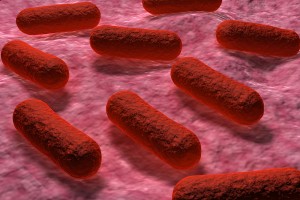One of the many strains of the bacterium E. coli (type 0157:H7) became famous after a 1982 outbreak of bloody diarrhea across the U.S. The infection could be traced back to contaminated hamburgers sold by a fast food chain. Canada also had some smaller food-related outbreaks, but a large disastrous outbreak occurred in Walkerton, Ontario. In this case the culprit was cow manure that was washed into surface water. The water was not optimally treated at the local water works and then consumed by the local community. It is important to know, that infection with E. coli bacteria can be spread in various ways as shown in this table.
The symptoms of infection usually present themselves after an incubation period of 3 to 8 days in the form of abdominal cramps, diarrhea that can also be bloody, and vomiting. Unfortunately, a more severe form can occur in 2 to 10% of patients due to the toxic substances of the bacterium. The dreaded form of “hamburger disease”, is medically known as hemolytic uremic syndrome, and children are at the highest risk, along with older adults or those with immune suppression (AIDS patients, cancer patients). The disease is life threatening, requires blood transfusions, dialysis and life-support therapy in an intensive-care unit setting.
| Hamburger disease is caused by: |
| Contact with livestock (or feces) |
| Human-to-human contact |
| Consumption of non-chlorinated contaminated water |
| Consumption of insufficiently cooked ground beef, salami, unpasteurized milk, even vegetables like lettuce or alfalfa sprouts that have not been washed. |
Prevention is of utmost importance, and fortunately a lot of it is common sense about food safety and safe food-handling practices:
| Hints to prevent Hamburger disease: |
| Wash your hands after handling animal and livestock after using the washroom and after changing diapers. |
| Wash your hands before and after preparing or eating food and handling raw meat. |
| Never put raw meat in contact with cooked meat and disinfect areas of meat preparation like counters or cutting boards. |
| Make sure all the pink color is gone from cooked meats, and juices after cooking should never be bloody! |
| Drink only pasteurized milk, fruit juices or ciders. |
| Never drink water from untreated sources (creeks, ponds). |
| Practice strict hand hygiene when dealing with persons who have diarrhea, especially when changing diapers of children with diarrhea. |
Besides prevention, vigilance is important: if any case of E. coli infection has been found, the local health units have to be notified, so the source of infection can be found and further spread can be prevented.
More info on food safety: http://nethealthbook.com/health-nutrition-and-fitness/nutrition/food-safety/
Reference: The Canadian Journal of Continuing Medical Education, September 2004, Vol.16, Nr.9, pg.49.
Last edited January 4, 2015






